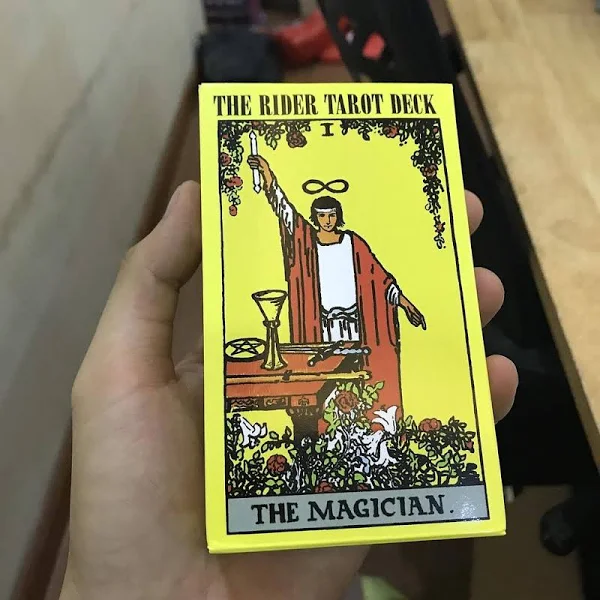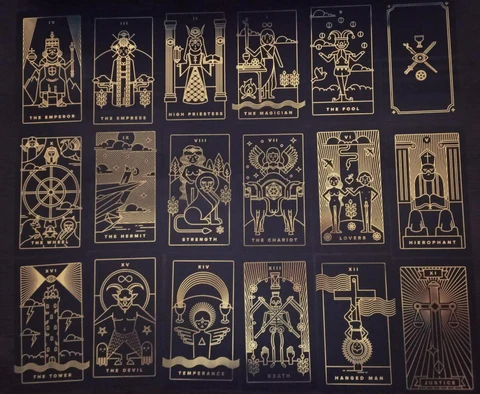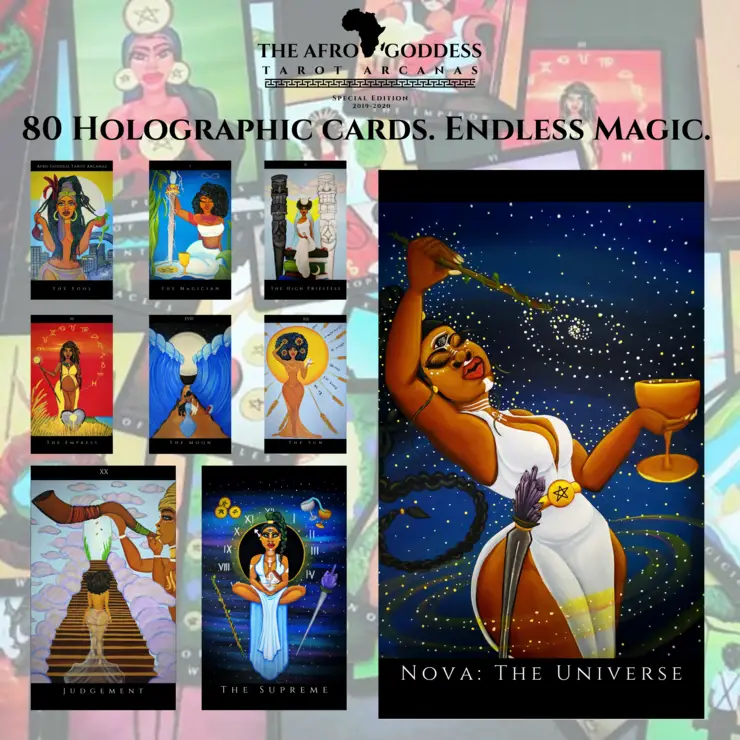Tarot reading, an age-old practice with deep-rooted historical and cultural significance, has evolved into a modern-day tool for introspection, self-discovery and prediction. This evolution is marked by a fascinating diversity of Tarot decks, each with its distinct artistic interpretation and symbolic resonance.
Understanding the array of Tarot deck types is vital in selecting the one that best resonates with your reading style and intuitive process. In this article, LotusBuddhas will give you an overview of the diverse world of Tarot cards, shedding light on the different types and their unique characteristics.
Traditional Tarot Decks
Traditional Tarot Decks form the foundation of tarot reading, carrying the legacy of a practice rooted in centuries of history, culture, and spirituality. These decks, by virtue of their design and interpretation, provide a consistent framework for understanding the nuanced narratives of life.
1. Rider-Waite Tarot Deck
The Rider-Waite Tarot Deck, conceived by Arthur Edward Waite and artistically brought to life by Pamela Colman Smith, is often considered the cornerstone of modern tarot reading. Published by the Rider Company in 1910, this deck is characterized by its rich, detailed symbolism, making it accessible to beginners and the preferred choice for many professional readers.
Comprising 78 cards, it includes 22 Major Arcana cards, which depict significant life events and spiritual lessons, and 56 Minor Arcana cards, which represent everyday experiences. The Rider-Waite deck revolutionized tarot reading by introducing pictorial scenes in the Minor Arcana, thus providing a more explicit narrative context to each card.
2. Marseille Tarot Deck
The Marseille Tarot Deck is one of the oldest tarot decks in existence, with its origins traced back to 15th century France. Its design is distinctly characterized by a unique woodcut artwork, a product of the era’s printing techniques.
This deck is distinguished by its non-scenic pip cards in the Minor Arcana. Unlike the narrative scenes in the Rider-Waite deck, these cards display the corresponding number of suit symbols (cups, coins, swords, and batons), which can make interpretation more reliant on a reader’s intuition and familiarity with traditional card meanings. This reliance on symbolism and intuition makes the Marseille Tarot Deck a captivating choice for seasoned readers.
3. Thoth Tarot Deck
The Thoth Tarot Deck is a product of the collaboration between Aleister Crowley, a renowned occultist, and Lady Frieda Harris, a skilled artist. This deck, created over five years in the early 20th century, is imbued with intricate symbology drawn from a range of disciplines including astrology, kabbalah and Egyptian mythology.
Like the Rider-Waite deck, the Thoth Tarot Deck has 78 cards. However, it diverges in terms of card names, images, and meanings, reflecting Crowley’s esoteric theories. The deck is known for its complex depictions and abstract symbolism, making it a fascinating choice for readers interested in deeper occult knowledge and spiritual exploration.
Modern Tarot Decks
Modern Tarot Decks embody the evolution of tarot reading, blending traditional symbolism with contemporary artistic expressions. These decks, while preserving the core structure of tarot, adapt and reinterpret the imagery to resonate with the evolving cultural and spiritual sensibilities of the current age.
1. Shadowscapes Tarot
The Shadowscapes Tarot, designed by artist Stephanie Pui-Mun Law, is a harmonious blend of fantasy and surrealism. Every card in this deck is a detailed watercolor painting, inviting the reader into a mystical world teeming with mythical creatures, enigmatic fairies and powerful symbols. This ethereal quality of the artwork provides a distinct depth to the readings and allows for intuitive interpretation.
While it draws upon the Rider-Waite system as a structural base, the Shadowscapes Tarot reinterprets the imagery through its unique lens. The deck, composed of 78 cards – 22 Major Arcana cards denoting spiritual lessons, and 56 Minor Arcana cards depicting day-to-day experiences – captivates the reader with its intricate layers of symbolism, offering a fresh perspective on traditional tarot reading.
2. Wild Unknown Tarot
The Wild Unknown Tarot, crafted by Kim Krans, marks a radical shift from conventional tarot imagery. It replaces the human figures traditionally central to tarot cards with a myriad of animals, trees and natural elements. The deck’s artistry is characterized by its strikingly minimalistic and monochromatic illustrations, interspersed with bursts of color, which create a sense of mystery and introspection.
As a 78-card deck, the Wild Unknown Tarot maintains the structural division of Major and Minor Arcana. However, the meanings of the cards are subtly reimagined to reflect the deck’s theme of nature and wilderness. This distinctive interpretation has made the Wild Unknown Tarot a favorite among contemporary Tarot enthusiasts, particularly those drawn towards nature and animal symbolism.
Thematic Tarot Decks
Thematic Tarot Decks showcase the dynamic adaptability of tarot symbolism, expressing distinct themes and perspectives through unique artistic interpretations. These decks highlight the universality of tarot’s foundational concepts while exhibiting the diversity of its application across various cultural, spiritual, and personal contexts.
1. Golden Thread Tarot
The Golden Thread Tarot, created by Tina Gong, is a digital-physical hybrid that seamlessly integrates technology with the timeless practice of tarot reading. The deck is visually striking, featuring minimalist, black and gold illustrations crafted with the intention of engaging the intuition of the reader.
While the deck maintains the traditional structure of 78 cards (22 Major Arcana and 56 Minor Arcana), it offers a unique reading experience through its companion app. The app provides digital readings, logs of readings for reflective purposes, and a comprehensive encyclopedia of card meanings, offering an innovative blend of the tangible and digital in tarot practice.
2. Afro Goddess Tarot Arcanas
The Afro Goddess Tarot Arcanas, designed by Andrea Furtick, is a vibrant celebration of African spirituality and the divine feminine. It weaves the historical and symbolic richness of African heritage into the structure and interpretations of tarot, offering a culturally resonant reading experience.
Drawing from both Rider-Waite and Thoth systems, the deck reimagines the tarot imagery within the context of Afrocentric aesthetics and spirituality. It consists of 78 cards, maintaining the division between the Major and Minor Arcana, each card deeply symbolic of the multifaceted African diasporic experience and Afrofuturism.
3. Food Fortunes Tarot
The Food Fortunes Tarot is a playful reinterpretation of traditional tarot, replacing conventional symbols with food items. Created by Josh Lafayette, this deck presents an innovative approach, connecting the universal experience of food with the intuitive process of tarot reading.
The deck maintains the original 78-card structure but translates the conventional figures and symbols into culinary delights. The result is a whimsical and engaging deck that adds a touch of humor and novelty to tarot reading, while opening up new avenues for interpretation based on personal associations with food.
Conclusion
If you want to become a professional Tarot reader, understanding these Tarot decks will enrich your reading experience, and deepen your connection to this ancient practice. Even so, LotusBuddhas would like to emphasize that the best Tarot deck is the ones that “talk” to you personally, reflect your intuition, and align with your spiritual journey.
You can also refer more:
- How to choose the right Tarot deck: https://lotusbuddhas.com/how-to-choose-the-right-tarot-deck.html
- The meaning of reversed Tarot cards: https://lotusbuddhas.com/the-meaning-of-reversed-tarot-cards.html
- 5 Mass Market Tarot Decks for Beginners: https://www.youtube.com/watch?v=Os07sFLwCg4













